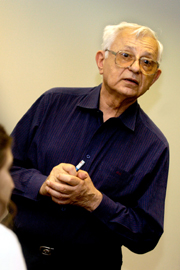NIH Award from the National Cancer Institute
Dissection of the Functions of Herpes Simplex Virus ICP0
- Principal Investigator: Bernard Roizman, ScD, Joseph Regenstein Distinguished Service Professor of Virology; Chairman, Viral Oncology Laboratory
- Start Date: September 30, 2009
- Total Award Amount: $581,604
Public Health Relevance
This revision of the R37 CA78766 grant takes advantage of accrued knowledge to ablate the diseases and suffering caused by reactivations of latent Herpes Simplex Viruses (HSV). The major problem facing development of specific treatment of latency is that in the course of the establishment of latency and its maintenance most of the viral genome is silenced by cellular proteins. If we could substantiate the proposed mechanisms by which the virus is silenced, we could devise screens for small molecule drugs that either enhance the silent state and preclude reactivation or reactivate viral replication in the presence of antiviral drugs.
Project Description
Diseases and suffering caused by reactivations of latent Herpes Simplex Viruses (HSV) remain a major medical problem notwithstanding effective attenuation of disease by currently available antiviral drugs. The major problem facing development of specific treatment of latency is that in the course of the establishment of latency and its maintenance most of the viral genome is silenced by cellular proteins. What we do not know is the mechanism by which the infected neuron silences the viral genome. If we knew the mechanisms by which the virus is silenced, we could devise screens for small molecule drugs that either enhance the silent state and preclude reactivation or reactivate viral replication in the presence of antiviral drugs.
This revision of the R37 CA78766 grant takes advantage of accrued knowledge to address this issue. The R37 CA78766 grant focuses entirely on ICP0, a herpes simplex virus regulatory protein that is emerging as a key regulator of viral gene expression in both productive infections and in the establishment and maintenance of latency. In brief, in the past 3 years we have made a fundamental discovery that ICP0 plays a key role early in productive infection in suppressing the cellular machinery whose main objective is to silence viral DNA. The machinery employed by the cells in its attempt to silence HSV DNA consists of a complex containing HDAC-1 or -2, CoREST, REST and LSD1. Of particular interest is the fact that CoREST and REST are known as repressors of neuronal genes in non neuronal cells. LSD1 - the lysine specific demethylase along with HDAC1 or HDAC2 play a key role in this process. This complex is disassembled by ICP0, phosphorylated by viral protein kinases and expelled from the nucleus.
The discovery of the role of the HDAC1 or -2/CoREST/REST/LSD1 in suppressing viral gene expression in productively infected cells raises the interesting question whether components of this complex also act as repressors of viral gene expression during latency. This hypothesis is tested in Aim 1 of the Competitive Revision Application. The objective of the second aim is to define the role of a set of viral micro RNAs that target the genes encoding ICP0, ICP4 and ICP34.5. It has been suggested, but not proven, that these micro RNAs play a role in silencing key genes to enable the maintenance of the silent state of the viral genome during latency. There is, however, an alternative hypothesis based on observations that HSV down regulates the synthesis and function of regulatory proteins including ICP0 in the course of productive infection. The available data also support the hypothesis that the viral micro RNAs are components of this regulatory network.
These aims are as follows: Aim 1. To test the hypothesis that components of the HDAC-1 or -2, CoREST, REST and LSD1 complex enable establishment of latency by silencing the HSV genome upon entry into the sensory neurons of trigeminal ganglia in vivo. Neuronal cells contain components of the complex described above. We plan to construct viruses that disrupt the complex in the same way that we have shown that in non neuronal cells disruption of this complex complements ?ICP0 minus viruses. In carefully controlled experiments we plan to determine whether disruption of the suppressor complex precludes or diminishes the establishment of latency. Aim 2; To determine whether the micro RNAs reported as potential candidates for suppression of ICP0 and ICP34.5 play a role in establishment of latency or whether they suppress the synthesis or function of ? ( immediate early) regulatory proteins ICP0, ICP22 and ICP4 or both. We have a large number of mutants in the domain of the HSV genome in which the micro RNAs map. It is relatively easy for us to construct viruses that fail to express the micro RNAs. These mutants and the restored wild-type viruses will be tested with respect to their ability to establish and maintain latent infections. The studies will be completed during the two year grant period. We anticipate that these studies will identify targets for development of drugs that control latency studies and contribute to the design of screens for small molecule inhibitors.
This award is funded under the American Recovery and Reinvestment Act of 2009, NIH Award number: 3R37CA078766-12S1

Bernard Roizman, ScD,
Joseph Regenstein Distinguished Service Professor of Virology; Chairman, Viral Oncology Laboratory
